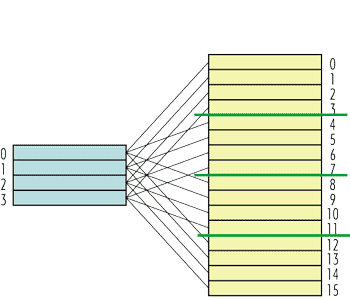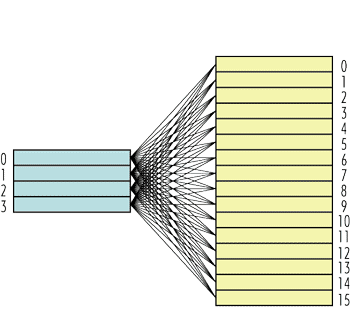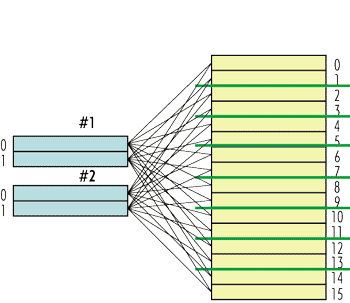04. Cache
- «Speed»: latency
- «Speed»: trhoughput
- + (hardware specific) «Speed»: granularity (e. g. reading from disk by sectors vs. reading from disk cache by bytes)
- Cache
- keeping an actual part of «slow» storage data on «fast» storage
Why cache < storage?
- Cost: energy, money
- Effectiveness (search among lesser data / decoding lesser address)
What is «actuality»? See Locality_of_reference
- Temporal locality (once referenced ⇒ can be referenced soon again)
- Spatial locality (once referenced ⇒ neighbours can be referenced soon)
(other: branches and equidistant references)
What to keep in cache:
- What was read from storage
+ certain amount of following data (e. g. disk read)
- + prediction voodoo (e. g. equidistant)
TODO What to throw out of cache:
- Random: easy implementation, but inefficient;
LFU (less frequently used): need counters and age meters, and search;
- LRU (less recently used): need age and search;
- FIFO: relatively easy, but ineffective
FIFO+LRU: needs direct queue modification, but no age/counters (newly arrived element appends (or moves) to te top of the queue
There always is worst case algorithm for every cache architecture.
- Cache hit
- access to cached element
- Cache miss
- access to non-cached element
We must know address (storage index) of cached element. If element is too small, caching is ineffective because of too much metadata:
| 00 | 10 04 00 00 | a0 78 4f 95 |
- 8 bits — age
- 30 bits — address
- 32 bits — cached word
38 bits of metadata over 32 bits of data.
Note: address is 30 bits instead of 32 because we need no trailing two bits, which are zero if we addressing a word (4 bytes) instead of byte.
So let's go further and cache a whole memory block:
| 00 | 10 04 00 | a0 78 4f 95 … 34 45|
- 8 bits — age
- 24 bits — address tag
- 8192 bits — cache line (256 words)
32 bits of metadata over 8192 bits of data.
- Tag
- part of memory address that corresponds to a memory block
- Line
- memory block that corresponds a tag
Caching a line of words at once (and probably by access to one word only) is statistically good tactics because of spatial locality
Direct cache
A line can cache one of selected list of blocks. If tags are equal, this is hit, if not equal or unused, this is miss (and cache line is filled).

- Tag size = number of concurrent lines bit length (address // cache size)
- Line number = cache size // line size
- (this is commonly used formula)
- Complies to spatial locality, but weak to locality breaches
- Has effective implementation
Associative cache
Any line can cache any memory block (aligned to cache line size).

- Tag size = number of blocks (address // line size ) ⇒ larger than in direct cache
- Line numbers are stored when cached
Needs hardware implementation of tag searching (we don't know where line is cached, if it is)
- ⇒ Effective if small
- Complies to temporal locality, strong to spatial locality breach
Multi-associative cache
How to violate spatial locality:
- Perform random access to various addresses (rarely accidental)
Have more than one spots of code/data flow (e. g. in multitasking environment, and that is common)

Multi-associative cache is superposition of direct and associative cache:
- Each bank works as direct cache
- ⇒ tag size is equal to direct cache tag size
- There are a number of banks, and data is searched among them in associated manner
- Depending on number of banks, search is relatively fast
- Can hold multiple locality spots
Write cache
- Increases performance
- Temporal locality ⇒ multiple write to cache leads to single writ to storage
Cache strategies:
- Write through: no write cache
- if already cached — need to update
- if cache is missed:
- do nothing (only reads are cached)
- or
- also cache data as if there was read (but this adds complexity and is unexpectedly ineffective)
- do nothing (only reads are cached)
- Write back: program continues after writing to cache, actual memory write is performed «at the background» somehow
- hot line: cache line that is no synchronized with memory
- temporal locality: keep hot lines in cache as long as possible
any other memory access, read or write, (e. g. DMA) must be
- restructured to work through cache
- or
- cause cache flush
- or
- invalidate corresponded cache line
- restructured to work through cache
- hot line: cache line that is no synchronized with memory
